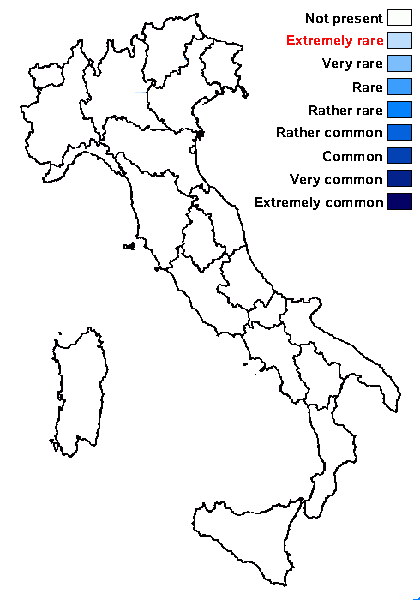Aspicilia goettweigensis (Zahlbr.) Hue
Nouv. Arch. Mus. Hist. Nat., Paris, 5 sér., 2, 1: 112, 1910 (1912). Basionym: Lecanora goettweigensis Zahlbr. - Annln K. K. naturh. Hofmus. Wien, 20: 346, 1905.
Synonyms:
Distribution:
Description: Thallus crustose, episubstratic, olive-brown to pale grey, sometimes white-pruinose, 0.5-1.5 mm thick, verrucose-areolate to subsquamulose-areolate. Areoles convex, up to 1.5 mm wide, the oldest ones bullate and often becoming hollow and cracked, sometimes upright and appearing subsquamulose, with an exposed white medulla. Cortex paraplectenchymatous, 15-25(-30) µm thick; medulla white, I-. Apothecia lecanorine-aspicilioid, at first immersed but very soon sessile and finally constricted at base, round to irregular, 0.5-1.5 mm across, with a black to brownish black, usually epruinose, concave to slightly convex disc, and a well-developed, raised, sometimes lobulate thalline margin. Proper exciple 22-32 µm thick in upper part, becoming thinner downwards; epithecium olive-brown, N+ green, K+ brownish; hymenium colourless, (75-)85-105 µm high, I+ pale blue, then reddish; paraphyses coherent, 1.5-1.7 µm thick, submoniliform, the apical cells 3-3.5 µm wide; hypothecium colourless, 30-60 µm high. Asci 8-spored, broadly clavate, the thin outer coat K/I+ blue, the wall and apical dome K/I-. Ascospores 1-celled, hyaline, ovoid or broadly ellipsoid, (14.5-)16-22 x (9-)11-14 µm. Pycnidia black, immersed, with a pale wall. Conidia thread-like, straight, (8-)14-18(-20) x c. 0.8-1 µm. Photobiont chlorococcoid. Spot tests: cortex K-, C-, KC-, P-; medulla K+ yellow (reaction to be observed on sections under the microscope). Chemistry: medulla with stictic acid (major), without or with traces of norstictic and connorstictic acids.
Note: a long-neglected or misunderstood silicicolous species reported from a few localities in the Alps (Switzerland, Austria), mostly below the subalpine belt, in sunny and dry situations; to be looked for in the Italian Alps. For further details see Paukov & al. (2016).
Growth form: Crustose
Substrata: rocks
Photobiont: green algae other than Trentepohlia
Reproductive strategy: mainly sexual

Predictive model
Growth form: Crustose
Substrata: rocks
Photobiont: green algae other than Trentepohlia
Reproductive strategy: mainly sexual

Predictive model
 Index Fungorum
Index Fungorum
 GBIF
GBIF

